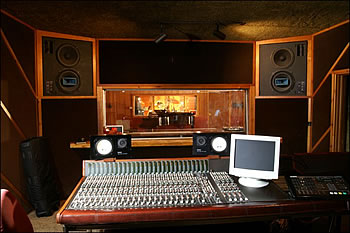Practical Acoustics
Control Room Video Monitor positioning

Most music studios were not designed with video screens in mind. They tend to get added in as a necessary afterthought. Here, I show the good, the bad, and the ugly.
Studio Construction
Slideshows showing each stage of Forge Studio being built can be seen here: http://www.forgerecording.com/recording/studio_construction.htm
and here is another one - Gino Robair is detailing his studio build in this Mixblog
and here is another one - Gino Robair is detailing his studio build in this Mixblog
Reverb Factory
The astonishing history of reverberation can be found here: <http://uncyclopedia.wikia.com/wiki/Reverb_factory>
Virtual Surround
Any surround sound system reproduces the sound source from multiple directions (ie more than two). Results can be dramatic but the extra complexity and cost limits the appeal of such systems. An alternative approach is to try to trick the listener into thinking he/she is hearing direct sounds from many directions from an ordinary stereo pair of loudspeakers. The generic name for this is “virtual surround”.
The principle that virtual surround works on is complex. It relies on the psycho-acoustic fact that part of our ability to distinguish sound directivity is due to the Inter-aural Time Difference (ITD). This is the arrival time delay between the ears. There is also a complex comb filtering relationship in the pinna (visible ear) and ear canal. Virtual surround attempts to generate similar transformations to the pinna and thereby fool the ear into hearing sound from a location other than between the two speakers. While it cannot rival a discrete multi-channel system (eg Dolby Digital), virtual surround can add an extra dimension to the sound.
Accuracy of location is somewhat limited, and results can vary significantly depending on listening position, and between listeners (each persons pinna transform is a unique pattern).
An example of a home theatre system using virtual surround is the Yamaha YSP1000. It uses 42 speakers in one box, which are driven from digitally phase-shifted signals to provide the 3D spatial image.
The principle that virtual surround works on is complex. It relies on the psycho-acoustic fact that part of our ability to distinguish sound directivity is due to the Inter-aural Time Difference (ITD). This is the arrival time delay between the ears. There is also a complex comb filtering relationship in the pinna (visible ear) and ear canal. Virtual surround attempts to generate similar transformations to the pinna and thereby fool the ear into hearing sound from a location other than between the two speakers. While it cannot rival a discrete multi-channel system (eg Dolby Digital), virtual surround can add an extra dimension to the sound.
Accuracy of location is somewhat limited, and results can vary significantly depending on listening position, and between listeners (each persons pinna transform is a unique pattern).
An example of a home theatre system using virtual surround is the Yamaha YSP1000. It uses 42 speakers in one box, which are driven from digitally phase-shifted signals to provide the 3D spatial image.
Acoustics Definitions
- Transmission
- Refraction
- Absorption
- Diffraction
- Reflection
- Diffusion
- Reverberation
A Room ƒ response
Here are the frequency response curves of the A room. They are from the Audient 'sweet spot' using the JBL 4412 soffit mounted mid field speakers, and the Genelec 1030a near field speakers situated just behind the meter bridge. The other two plots are from a position at the front of the rear wall couch (about 80cm from the wall).
| 4412.pdf | |
| File Size: | 28 kb |
| File Type: | |
| 1030.pdf | |
| File Size: | 28 kb |
| File Type: | |
| 4412_back.pdf | |
| File Size: | 28 kb |
| File Type: | |
| 1030_back.pdf | |
| File Size: | 28 kb |
| File Type: | |
Control Room Design
| control_room_chronology.pdf | |
| File Size: | 36 kb |
| File Type: | |
| cr_design_chronology.pdf | |
| File Size: | 75 kb |
| File Type: | |
